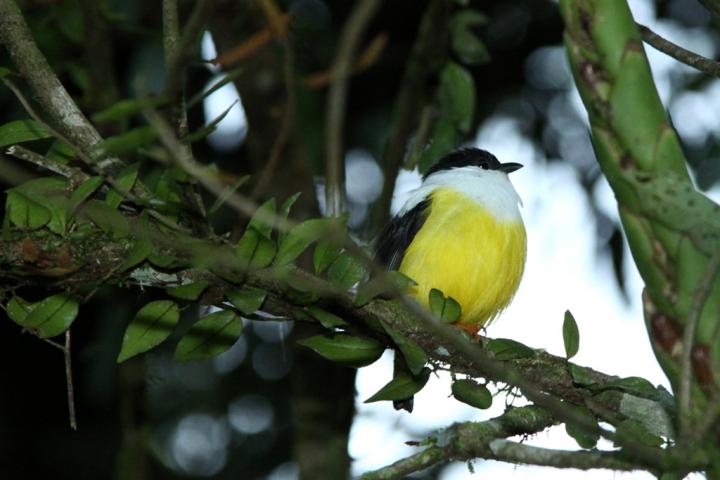Habitat degradation and climate shifts impact survival of the white-collared manakin

Climatic refuges, such as mature tropical forests, may be important for many resident tropical bird species such as the White-collared Manakin. Credit: Wikimedia Commons
Habitat alteration due to forest clearing and climate change threaten wildlife populations throughout the globe. To better understand the interacting effects of habitat degradation and climate on bird populations, researchers from the U.S. Forest Service Pacific Southwest Research Station (PSW), Klamath Bird Observatory, and Costa Rica Bird Observatories spent 12 years studying the White-collared Manakin, a fruit-eating tropical bird, in mature and young forests along the Caribbean coast of Costa Rica.
During the study, several El Niño and La Niña events–cycles of warm and cold ocean temperatures that influence air temperature and precipitation–resulted in very marked dry and wet annual conditions that allowed researchers to measure differences in manakin survival relative to climatic shifts. Results were recently published in the journal Oecologia.
In young tropical forests, researchers found dramatic decreases in manakins' survival during dry weather associated with El Niño. Researchers believe that, due to a sparser canopy and their fragmented nature, the young forests were more susceptible to understory drying that reduced fruit production.
Conversely, manakins' survival rates were higher during wet years associated with La Niña events in these young forests where increased moisture and sun exposure likely led to an abundance of fruit resources. In mature forests, researchers observed very stable manakin survival rates regardless of climatic shifts, suggesting a relatively constant abundance of fruit resources.
“The complex structure of mature forest is thought to serve as a climatic refuge, buffering fruiting plants from climatic changes resulting in stable manakin survival,” says Jared Wolfe, a postdoctoral researcher with PSW and Klamath Bird Observatory and the study's lead author.
“Climatic refuges, such as mature tropical forests, may be important for many resident tropical bird species faced with the decreasing availability of mature forests coupled with increases in the severity of El Niño-associated dryness.”
These study results represent the first published documentation of El Niño's influence on the survival of a resident tropical landbird. Researchers believe that variation in manakin survival between forest types provides insight into the sensitivity of certain species to habitat alteration.
“From a management perspective, understanding how climatic events affect biodiversity is critical for the development of science-based conservation strategies,” says Pablo Elizondo, the Costa Rica Bird Observatories' executive director and co-author of the study.
###
To read the paper, visit: http://www.
Headquartered in Albany, Calif., the Pacific Southwest Research Station develops and communicates science needed to sustain forest ecosystems and other benefits to society. It has research facilities in California, Hawaii and the U.S.-affiliated Pacific Islands. For more information, visit http://www.
Media Contact
All latest news from the category: Life Sciences and Chemistry
Articles and reports from the Life Sciences and chemistry area deal with applied and basic research into modern biology, chemistry and human medicine.
Valuable information can be found on a range of life sciences fields including bacteriology, biochemistry, bionics, bioinformatics, biophysics, biotechnology, genetics, geobotany, human biology, marine biology, microbiology, molecular biology, cellular biology, zoology, bioinorganic chemistry, microchemistry and environmental chemistry.
Newest articles

Simplified diagnosis of rare eye diseases
Uveitis experts provide an overview of an underestimated imaging technique. Uveitis is a rare inflammatory eye disease. Posterior and panuveitis in particular are associated with a poor prognosis and a…

Targeted use of enfortumab vedotin for the treatment of advanced urothelial carcinoma
New study identifies NECTIN4 amplification as a promising biomarker – Under the leadership of PD Dr. Niklas Klümper, Assistant Physician at the Department of Urology at the University Hospital Bonn…

A novel universal light-based technique
…to control valley polarization in bulk materials. An international team of researchers reports in Nature a new method that achieves valley polarization in centrosymmetric bulk materials in a non-material-specific way…





















